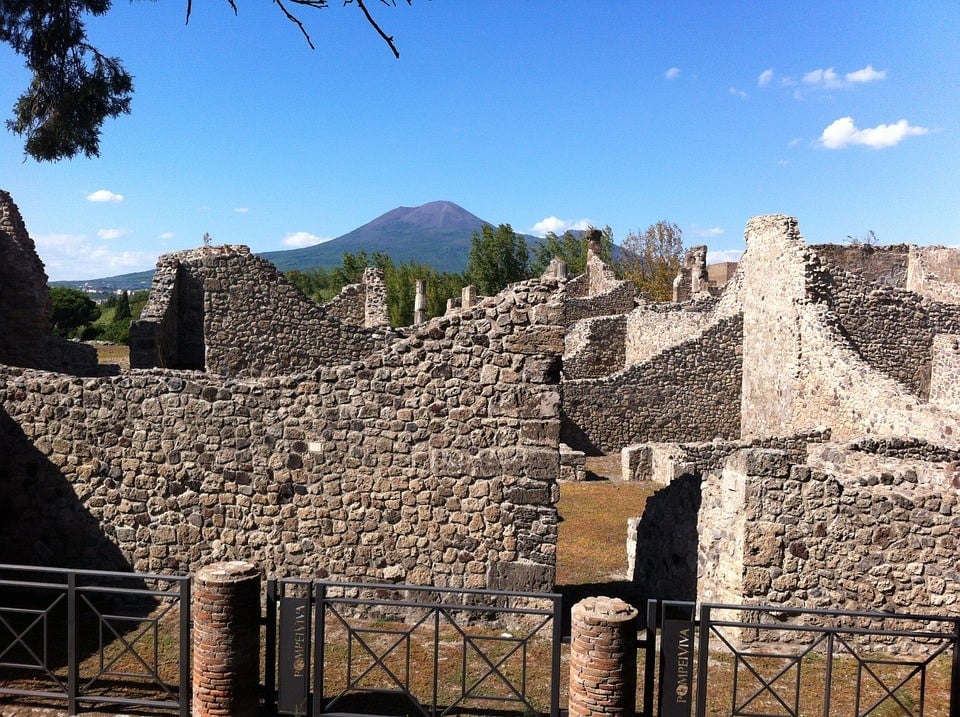Time travel might not be possible yet, but the archaeological site of Pompeii gets you pretty close. This thriving Ancient Roman city has become frozen in time due to the catastrophic explosion of Mount Vesuvius in 79 AD. The city remained buried in ash and pumice for almost 2000 years until it was rediscovered by a group of explorers in 1748. To the intellectual delight of both historians and archaeologists alike, they were given an almost perfect time capsule of Pompeii at the time of its demise.
Today’s scholars have a myriad of materials at their disposal to study including paintings on the walls, mosaics, and the many artifacts scattered among the city. Even jars with preserved bread and fruit have been discovered. During excavations archaeologists also noticed hollowed-out cavities, which, when filled with plaster, they realized were the final resting positions of some of Pompeii’s citizens. Being such a large and important city, much of it is still being excavated to this day. When you walk through its streets, you can see the remnants of elaborate villas, elegant houses, amphitheatres, as well as artisan shops, taverns, bathhouses, and even brothels.
When walking through Pompeii, students are able to marvel at just how much our society has in common with these people who lived so long ago. They don’t just have to imagine though, archaeologists have also been fortunate enough to unearth written descriptions of Pompeii, along with eye-witness descriptions of the explosion of Mount Vesuvius, written by none other than Pliny the Younger! ‘‘…its general appearance can best be expressed as being like an umbrella pine, for it rose to a great height on a sort of trunk and then split off into branches…’’ Did you know the type of eruption witnessed by Pliny the Younger is now referred to by scientists as a Plinean eruption? Why not teach your students all about Pompeii using both science and history!

Interdisciplinary History and Science Student Project: Pompeii and Mount Vesuvius
Why not transform learning about Pompeii into an interdisciplinary history and science project?
History and the Importance of Primary Sources
In history class, students can learn about the importance of using primary sources when studying ancient times. Alone or in groups they can read the two letters sent to Tacitus describing the eruption of Mount Vesuvius written by Pliny the Younger. This can be done as a reading comprehension, or perhaps have them imagine what the explosion would have been like from the perspective of a person living at that time, write it down, and then compare it with Pliny’s writing.
Science: Archeology and Geology
With the cooperation of the science teacher students can then be introduced to two very important subfields of science; archeology and geology!
For archaeology, students can research some of the artifacts that were found at Pompeii, (jewellery, medical instruments, mosaics, urns, plumbing pipes, etc.) and try to decipher what they meant for society at that time. What scientific techniques do we use to date artifacts?
For geology, students have the opportunity to learn all about volcanoes. What warning signs did the citizens of Pompeii miss because science wasn’t advanced enough at that point? This can also be an opportunity to read writings by Pliny the Elder, who was a natural scientist at the time. (He thought storms were a potential indicator of eruptions, but did not mention seismic activity.) They can also compare the eruption of Vesuvius to more modern eruptions.
Let students use their creativity and be inspired by how they can combine these two fields in a culminating project on Pompeii.
Benefits of an Interdisciplinary History/Science Project
Research has repeatedly shown that an interdisciplinary approach to teaching has a profound, positive impact on student learning and success.
By combining a historical event to modern science, teachers are able to increase student engagement and build student background knowledge by providing context necessary for learning. History and science can serve as a learning scaffold and provide teachers with a fun and easy way to differentiate instruction for different types of learners.
Visit Vesuvius and the Archaeological site of Pompeii During Your Student Trip to Italy
When planning a student trip to Italy, don’t forget to include a stop in Naples in order to drive down to the archaeological site of Pompeii and Vesuvius to discover the history and science behind it. To begin planning your customized Italian itinerary, contact a Prométour Tour Consultant today and feel free to download our free guide below!



